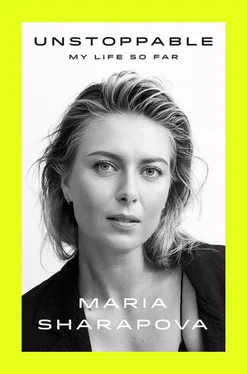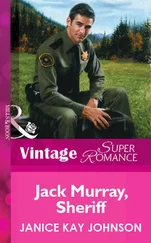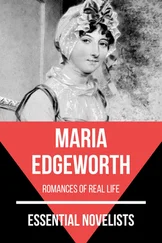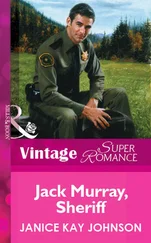He deserved that recognition more than anyone practicing on those courts, but it didn’t make me feel any better. And I couldn’t quite understand why.
I played Sloane Stephens in the first round. Jimmy sat in my player box wearing an ironed white button-down shirt. I lost in three sets. But nothing about the match, the way I played, or the result mattered to me. All I could think about was that this partnership had no future. How was I going to get out of it without hurting his feelings? How would I tell the world I am firing Jimmy Connors after just one match?
The walk back to the locker room was painful; the talk with Jimmy was even worse. He said I had played well. “Don’t put your head down. It’s a long road ahead; we have the U.S. Open coming up.” Except it wasn’t. Not together, at least.
I was quiet, just nodding to his postmatch delivery. My first few words came out at the drive-through of a Wendy’s a half hour later. When all things are going wrong, there’s little that a spicy chicken sandwich can’t fix. Milk shake. Fries. I ordered it all. And finished it in the car way before we pulled up to the driveway of the house we were renting. That night, we sat at the dining room table until 4:00 a.m. It was me, Grigor, my hitting partner Dieter, my fitness coach Yutaka, and my physical therapist at the time, Juan. Nothing about that evening felt promising. We were in someone else’s house, in the middle of nowhere in Mason, Ohio, sitting there with only one thing on our mind: How were we going to tell Connors?
The truth is, there is no nice way or right way to say we are finished. I am not sure how he felt about it. He must have been furious, but we did not have a close enough relationship for me to find out. I knew it was the right decision.
The match against Stephens ended up being the last of my season that year. My shoulder was becoming a problem again: there was that unavoidable pain. Those few months off, they gave me a chance to settle down, to look for the right person. I also didn’t have to face journalists and answer their questions about Connors. My shoulder problem proved to be a blessing in disguise.
In 2013, I began looking for a new coach. You interview the coach, but the coach also interviews you. You have to be on the same page, be chasing the same thing, have the same sort of plan and goal in mind. In the end, one candidate stood above all the others: Sven Groeneveld, a Dutch pro who, after his own career, had coached a handful of excellent players, including Monica Seles and Mary Pierce. I first met Sven in the lobby of a New York hotel during the U.S. Open. I’d withdrawn because of a shoulder injury. He was ten minutes early, which didn’t really work in my favor—I walked into the lobby holding a vanilla ice cream cone with sprinkles that I’d just bought from the ice cream truck around the corner. I am sure he assumed I was going to throw the rest of it away as we began speaking about the possibility of working together, but nothing gets in the way of my vanilla cone with sprinkles. So I kept going at it, mumbling questions and replies. At the time, he was running a player development program on tour. It was a good job and a good life and he was making good money, but he missed the competition of the game. He wanted to get back into the thick of it. I had to make sure he could help me, give me something new, and he had to make sure I was in it for the right reasons, that I was ready to do what I had to do to win, that the fire still burned, before he hitched his career to my own. He was worried, he told me later, that I was already thinking of the end, the graceful bow-out. He did not want to quit his own life just to be part of someone else’s farewell tour.
When I sat down with Sven for this book, I asked him exactly why he’d decided to come aboard. He laughed and said, “Well, Maria, I was in fact concerned. I said to myself, ‘Here is a player who is not all that far away from thirty, and, you know, the average tennis career, for women in this sport, can end in their late twenties. And here’s a player who has already done everything. Won every Grand Slam, been the top rank in the world. So what’s she still doing it for?’ I asked you exactly that, and I was afraid you’d say you wanted to secure your legacy, or win one more Grand Slam, because that’s how it is with most players. But that’s not what you said. Do you remember? I asked, ‘What are you playing for now?’ And you said, ‘Because I want to beat them all.’ Right then, I said to myself, ‘I’m in!’”
I’ve worked harder with Sven than I’ve ever worked in my life. That’s how it has to be when you get a little older. You need to go twice as hard to look half as natural. You need to double your effort to get the same result. In other words, practice is everything. If you have a bad practice, you will have a bad match. If you let up for one day, you will most likely exit your next tournament one day early. In other words, you pay for everything. If you take a day for yourself here, you give up a day on the courts.
Sven and I clicked immediately. He’s become more than just a coach. He’s a confidant, an advisor, and a friend. How do you tell a real friend from a fake? Those who stick with you in the bad times as well as the good are your friends. The others fall off when the water gets rough, and good riddance. Sven has stuck with me through it all. Our partnership reached a real high in the spring of 2014 at the French Open. The clay, often a problem in the past, suddenly seemed to favor my game, the new game I’d slowly put together in the years after my shoulder surgery. This was a game built around the power of my return, those hard, flat backhands that could end a point from any place on the court. I’d actually come to love playing in Roland Garros, on the red clay of center court, with the colorful pennants that fly in the wind high above the stadium, the knowledgeable crowds, and of course Paris itself, which waits patiently to embrace its winner. I came in ranked at number seven. Serena Williams, who’d won the tournament the year before, entered at number one. But Serena went down in the second round—a huge upset. She lost in straight sets to the Spaniard Garbiñe Muguruza (who would also beat Serena in the final of the French in 2016, when I was out of the game). I cruised to the quarterfinals, where I faced, you guessed it, Garbiñe Muguruza. She won the first set, but she really did not challenge me the way she had challenged Serena. I beat her 1–6, 7–5, 6–1.
It didn’t get any easier from there. It took me three very tough sets to beat Eugenie Bouchard in the semifinals. Then I faced Simona Halep in the final. The match went on and on—over three hours. It seemed like we’d been trading ground strokes for our entire lives. At times, it felt like I was playing my best tennis. Other times, it felt like nothing was working for me. My serve deserted me for long stretches. Twelve double faults! No matter how hard I hit the ball, Halep seemed to find a way to hit it back. Ball after ball—they just kept coming. We traded the lead—back and forth, back and forth. And the heat! It was one of those matches that comes down to will. Who wants it more? Who refuses to quit? It was not going to be a question of who was better but of who was going to hang on, who was going to get up one more time than she’d been knocked down.
In other words, I simply refused to give in. I finally found myself serving for the match and the tournament at the end of a very long day. Halep returned my serve, and I hit a hard, flat shot, just the sort I had learned from Robert Lansdorp in another life, into her backhand corner. She got her racket on the ball, but barely, and the result was a pop fly that I watched and watched as it turned in the sky. It finally came down on the red clay, a couple of feet outside the line. I fell to my knees, put my face in my hands. If this was my last Grand Slam championship, then perfect! What better bookend to my first Wimbledon? I was so young at Wimbledon, too young, too new to the scene, to really understand what it all meant, and everything felt so easy, winners falling as naturally as rain on a tin roof. At the French in 2014, I was mature and the matches were hard. It was all struggle. It took so much work to overcome Halep, an opponent who, like me, refused to go away and die. If things had played out differently, she might have won the match. Then it would have been Halep holding the trophy at center court, but, on that day, it happened to be me.
Читать дальше












